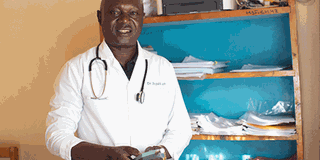Scientists discover new effective treatment for neglected skin disease

Dr Patrick Sagaki, the medical superintendent at Amudat Hospital, who treats Ugandan and Kenyan patients suffering from Kalaazar.
What you need to know:
- Currently, the standard treatment for PKDL is sodium stibogluconate (SSG), an injectable drug that is given for a lengthy 60-90 days.
- But the new treatment reduces hospitalisation days by over 50 per cent.
A more effective, shorter and safer treatment for post-kala-azar dermal leishmaniasis (PKDL), a neglected a skin disease, has been found following a successful clinical trial in Sudan.
The phase II clinical trial was conducted by the Drugs for Neglected Diseases Initiative (DNDi) and the Institute of Endemic Diseases at the University of Khartoum.
PKDL is a condition that develops after someone has received treatment for visceral leishmaniasis, a neglected tropical disease. People with PKDL get rashes around the mouth, which can spread to arms and upper body and eventually infect the entire body, depending on how severe it is.
According to the World Health Organization (WHO), detecting and treating the disease is key to eradicating it as sandflies, which transfer visceral leishmaniasis when infected and feed on PKDL lesions in people's wounds, spread the disease.
Currently, the standard treatment for PKDL is sodium stibogluconate (SSG), an injectable drug that is given for a lengthy 60-90 days. Patients are required to be admitted to a hospital for between two months to three months due to threatening toxicity of the medication, which requires that they are under close medical supervision.
But the new treatment reduces hospitalisation days by over 50 per cent. Patients will only need to stay in hospital for 14 days, during which they will receive an injectable paromomycin drug while simultaneously taking a drug called miltefosine orally. After discharge, patients can continue the oral dosage at home, with the total number of treatment days amounting to 42.
During the trial, which started in 2018, 98 per cent of patients who were put on the new treatment achieved complete cure. This is in comparison to a second group of participants on an alternative treatment. This second group was put on a regimen of miltefosine and injectable liposomal amphotericin B (MF+LAmB) for 28 days, stayed in the hospital for only seven days until the LAmB treatment ended and continued the oral treatment at home after hospital discharge. This group had an 80 per cent cure rate, with MF+LAmB proving to be a good treatment alternative.
“Treatment for PKDL in Sudan is currently only recommended for patients with severe or persistent disease, mainly because sodium stibogluconate is prolonged, toxic and expensive. But we have now found a safer and better treatment option, where patients only need to be admitted to hospital for 14 days and then complete the oral treatment at home. This makes it more patient-friendly, which is important since most people affected by this terrible disease are children,” said Prof Ahmed Musa, senior investigator for Leishmaniasis from the Institute of Endemic Diseases, University of Khartoum.
Dr Fabiana Alves, director of the Leishmaniasis Cluster at DNDi , noted that for a long time, patients with PKDL in Eastern Africa have been left behind by medical research because the disease is not considered life-threatening. “Many have had to endure not only stigma but expensive, lengthy treatments exposing them to toxicity. But this new, shorter, and better treatment will improve the lives of these neglected patients and also help reduce VL transmission on our road to elimination.”
Dr Cherinet Adera, senior market access manager, DNDi, explained that the actual burden of PKDL in Kenya is unknown though various medical journals estimate that PKDL occurs in less than five per cent of visceral leishmaniasis cases.
“The condition doesn't cause any physical discomfort, but the rash on the skin can cause social discomfort, embarrassment, social isolation, stigmatisation and even affect self-esteem. This can lead to emotional distress (anxiety, depression). The rash is usually on the face, upper arms and trunk but can be on any part of the body and can cause disfiguring,” she said.
She said the treatment will be made commercially available depending on the timeline when WHO releases PKDL treatment guidelines and when the Ministry of Health adopts the WHO recommendation.
In June, WHO launched a strategic framework for elimination of visceral leishmaniasis in Eastern Africa, with the region given targets to achieve by 2027, and by 2030.
The midterm regional targets, which should be achieved by 2027, include reducing new cases by 60 per cent, ensuring 100 per cent HIV screening for all detected cases and 100 per cent reporting of the results, ensuring that 75 per cent of cases are detected and started on treatment within 30 days’ onset of symptoms, and to reduce the number of resultant deaths.
The overall regional targets to be achieved by 2030 include ensuring that there are less than 1,500 new cases reported each year, detecting and treating 90 per cent of visceral Leishmaniasis cases within 30 days of onset of symptoms, ending all deaths from the disease in children, starting patients living with HIV and infected with visceral Leishmaniasis on antiretroviral therapy and referring them to HIV clinics for long term management, and for all PKDL cases to be detected, reported and managed.





